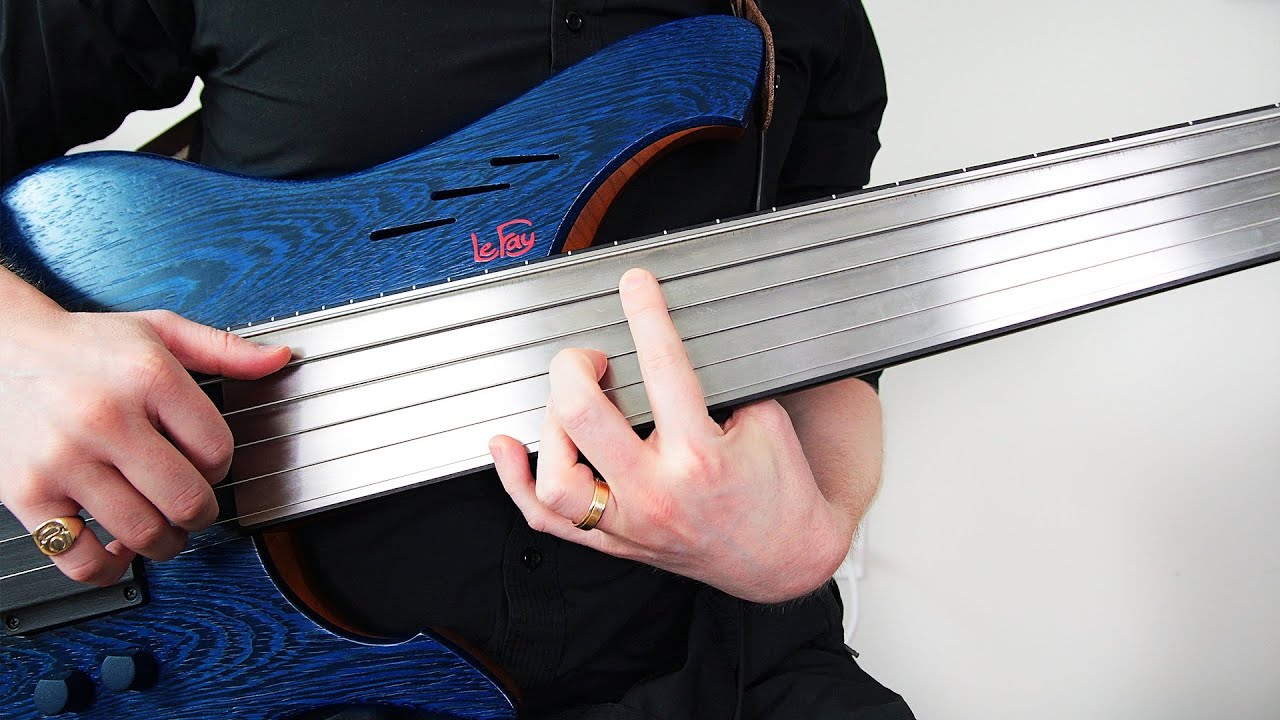Home>Instruments>Bass>How To Play 4 String Bass


Bass
How To Play 4 String Bass
Modified: January 22, 2024
Learn how to play the 4 string bass with step-by-step instructions and techniques. Enhance your bass playing skills and master the art of playing the bass guitar.
(Many of the links in this article redirect to a specific reviewed product. Your purchase of these products through affiliate links helps to generate commission for AudioLover.com, at no extra cost. Learn more)
Table of Contents
- Introduction
- Choosing the Right 4 String Bass
- Understanding the Basics of 4 String Bass
- Proper Finger Placement and Technique
- Learning Essential Scales and Arpeggios
- Mastering Basic Basslines
- Developing Rhythm and Timing
- Expanding Your Playing with Slap and Pop Techniques
- Utilizing Fingerstyle and Pick Techniques
- Exploring Different Music Genres on 4 String Bass
- Tips for Practicing and Improving
- Conclusion
Introduction
Welcome to the world of bass playing! Whether you’re a beginner or an experienced musician looking to try something new, learning to play the bass guitar can be an exciting and rewarding journey. Among the different types of bass guitars available, the 4 string bass is a popular choice due to its versatility and ease of play. In this article, we will explore the fundamentals of playing the 4 string bass and provide you with valuable tips and techniques to help you become a proficient player.
A 4 string bass guitar typically features four strings tuned to the standard EADG. This means the lowest string (E) is at the bottom, followed by A, D, and the highest string (G) at the top. The 4 string bass is widely used in various music genres such as rock, pop, funk, jazz, and more.
Before diving into the techniques and strategies for playing the 4 string bass, it’s important to understand the significance of this instrument in a band or musical ensemble. The bass guitar plays a crucial role in providing the foundation and groove to the music. It acts as the bridge between the rhythm and melody while contributing to the overall harmony.
As a bass player, your primary responsibility is to maintain a solid and consistent rhythm. You’ll work closely with the drummer to establish the heartbeat of the music. Additionally, you’ll have the opportunity to showcase your creativity by playing melodic bass lines, improvising solos, and adding subtle embellishments to enhance the musical arrangement.
Whether you aspire to be a professional bassist or simply want to enjoy playing for your own personal satisfaction, learning the 4 string bass opens up a whole new world of musical possibilities. So, grab your bass guitar, get ready to groove, and let’s embark on this exciting journey together!
Choosing the Right 4 String Bass
When it comes to selecting the right 4 string bass, there are a few factors to consider that will greatly impact your playing experience and sound. Here are some key points to keep in mind:
- Budget: Determine your budget range for purchasing a bass guitar. There are options available for every budget, so make sure to set a realistic figure.
- Body Type: Bass guitars come in various body shapes such as precision, jazz, and modern. Each body type produces a different tone, so it’s essential to choose one that aligns with the music genre you intend to play.
- Tone Preference: Consider the tone you’re aiming for. Do you prefer a warm, rounded tone or a bright and punchy sound? This will guide you in selecting the right pickup configuration for your bass.
- Neck Profile: The shape and profile of the neck greatly impact playability. Experiment with different neck profiles to find one that feels comfortable in your hand.
- Scale Length: The scale length affects the overall feel and tension of the strings. Short scale basses are ideal for players with smaller hands, while long scale basses offer more string tension and extended reach.
- Playability: Test the bass by playing it to assess its overall playability. Ensure that the frets are well-installed and the strings are properly aligned for easy navigation.
It’s highly recommended to visit a music store and try out different bass guitars before making a purchase. This hands-on approach allows you to feel the instrument, try different playing techniques, and hear how it sounds through an amplifier.
Additionally, don’t forget to consider the aesthetic appeal of the bass guitar. It’s important to choose a bass that visually inspires you and makes you feel excited to pick it up and play.
Remember, choosing the right 4 string bass is a personal decision. Take your time, do your research, and find a bass that suits your preferences, budget, and musical goals. With the perfect instrument in your hands, you’ll be motivated to practice and explore the incredible world of bass playing.
Understanding the Basics of 4 String Bass
Before diving into playing the 4 string bass, it’s important to have a good understanding of the instrument and its basic components. Let’s take a closer look at the key elements of a bass guitar:
- Neck: The neck is the long, slender part of the bass that holds the frets and strings. It is usually made of wood and connects to the body of the bass.
- Frets: Frets are the metal strips that run horizontally across the neck. They divide the neck into specific intervals, allowing you to play different notes by pressing the strings against them.
- Strings: The 4 string bass, as the name suggests, has four strings. They are usually made of steel or nickel and are tuned to the standard EADG.
- Headstock: The headstock is located at the top of the neck and holds the tuning pegs. These pegs allow you to adjust the tension of each string to achieve the desired pitch.
- Pickups: Pickups are the magnetized components located beneath the strings. They detect the vibrations of the strings and convert them into electrical signals, which are then sent to an amplifier or audio system.
- Controls: The controls on a bass guitar typically include knobs for adjusting volume, tone, and sometimes additional settings such as pickup selection.
- Bridge: The bridge is the assembly that anchors the strings at the bottom of the bass. It helps to transmit vibrations from the strings to the body, contributing to the instrument’s overall tone.
Once you are familiar with the basic components of a 4 string bass, it is important to understand how to hold and position the instrument correctly. Place the body of the bass against your chest, with the neck tilted slightly upward. Use your left hand to support the neck and place your right hand near the bridge.
Next, let’s explore the concept of fretting. To produce different notes on the bass, you will press down on the strings against the frets. Start by placing your index finger behind the first fret, and press the string down firmly but not forcefully. This technique is called fretting, and it allows you to change the pitch of the note produced by the string.
Understanding the basic components of a 4 string bass and how to hold and fret the instrument properly is crucial for any aspiring bass player. Take the time to familiarize yourself with these fundamentals, as they will serve as the foundation for your bass playing journey.
Proper Finger Placement and Technique
Developing proper finger placement and technique is essential for playing the 4 string bass effectively and efficiently. Good technique not only improves your playing speed and accuracy but also helps prevent strain and injury. Here are some tips to keep in mind:
- Hand Position: Start by placing your thumb on the back of the neck, opposite your fingers. This provides support and stability while allowing your fingers to move freely across the fretboard.
- Finger Placement: Each finger should be responsible for a specific fret. The index finger covers the first fret, the middle finger covers the second fret, the ring finger covers the third fret, and the pinky covers the fourth fret. Try to keep your fingers curved and close to the strings for better control.
- Pressure: Apply just enough pressure on the strings to produce a clear note. Pressing too hard can cause discomfort and hinder your playing speed, while pressing too lightly can result in muted or buzzing notes.
- Alternate Fingers: When playing a series of notes on a single string, use alternate fingers (index and middle, or middle and ring) to increase speed and maintain a consistent rhythm.
- Thumb Placement: Keep your thumb positioned behind the neck, directly opposite your fingers. Avoid letting it creep over the top of the neck, as this can limit your hand’s mobility and hinder your playing technique.
- Sliding and Vibrato: Experiment with sliding your fingers along the strings to create smooth transitions between notes. Additionally, practice adding vibrato to sustain a note and add expression to your playing.
- Muting: Rely on both your fretting hand and picking hand to control unwanted string vibrations. Use your fretting hand to lightly touch the strings you’re not playing, while using your picking hand to dampen or rest on the lower strings.
Remember, developing proper finger placement and technique takes time and practice. Start by playing slow and focus on accuracy and precision. Gradually increase your speed as you become more comfortable and confident with the instrument.
Additionally, take breaks and stretch your hands and wrists to avoid strain. Regular exercise and stretches specifically designed for musicians can help improve flexibility and prevent injuries.
By implementing these techniques and consistently practicing correct finger placement, you will enhance your playing ability and unlock a whole new world of possibilities on the 4 string bass.
Learning Essential Scales and Arpeggios
To become a proficient 4 string bass player, it is important to develop a solid foundation of scales and arpeggios. These musical patterns are the building blocks for creating basslines, improvising solos, and understanding the harmonic structure of songs. Here are some essential scales and arpeggios to focus on:
- Major Scale: The major scale is a fundamental scale used in many genres of music. It consists of a specific pattern of whole and half steps and can be played starting on any note. Learning the major scale in different positions on the neck will allow you to play melodies and basslines with ease.
- Minor Scale: The minor scale has a slightly different pattern of whole and half steps compared to the major scale. It has a more melancholic and somber sound and is commonly used in blues, rock, and jazz genres.
- Pentatonic Scale: The pentatonic scale is a five-note scale that is widely used in various styles of music, including rock, blues, and country. Learning the pentatonic scale in different positions on the neck will allow you to create melodic basslines and improvise solos.
- Blues Scale: The blues scale is derived from the pentatonic scale and adds an additional note, the “blue” note, which adds a distinctive bluesy flavor. It is commonly used in blues and rock music.
- Major and Minor Arpeggios: Arpeggios are broken chords that are played one note at a time. Major and minor arpeggios are essential for understanding chord progressions and creating melodic basslines that complement the harmony of a song.
- Chromatic Scale: The chromatic scale includes all twelve notes within an octave. Practicing the chromatic scale will help you develop finger dexterity, improve your fretboard knowledge, and assist in creating interesting and colorful basslines.
When practicing scales and arpeggios, start by playing them slowly and focus on accuracy and consistency. Pay attention to your finger placement and ensure that each note rings out clearly. Once you are comfortable with a particular scale or arpeggio, gradually increase your speed and challenge yourself with different rhythms and variations.
It is also beneficial to apply these scales and arpeggios to actual music. Play along with songs in various genres and try to incorporate the patterns you’ve learned into your basslines. This will help you internalize the patterns and develop a musical ear.
Remember, learning scales and arpeggios is an ongoing process. As you progress, you can explore more advanced scales and arpeggios, such as modes and extended arpeggios, to further expand your musical vocabulary and creativity on the 4 string bass.
Mastering Basic Basslines
One of the key aspects of playing the 4 string bass is mastering basic basslines. Basslines provide the foundation and groove of a song, and learning to create solid and rhythmic basslines is essential for any bass player. Here are some tips to help you on your journey to mastering basic basslines:
- Listen and Analyze: Take the time to listen to different songs and focus on the basslines. Pay attention to the rhythm, note choices, and how the bass interacts with other instruments in the band.
- Start Simple: Begin by learning simple basslines that consist of roots and fifths of chords. These foundational basslines provide solid support to the harmony of a song.
- Focus on Timing: Develop a strong sense of timing and groove. Practice playing along with a metronome or drum tracks to improve your ability to lock in with the rhythm section.
- Vary Rhythmic Patterns: Experiment with different rhythms and note durations. Playing around with accents, syncopation, and rests can add flavor and interest to your basslines.
- Explore Different Techniques: Incorporate techniques such as slides, hammer-ons, pull-offs, and muted notes to create dynamics and variety in your playing.
- Study Different Genres: Explore various music genres to expand your musical vocabulary and understanding of different bassline styles. Each genre has its own unique approach to bass playing.
- Improvise and Experiment: Once you have a strong foundation, feel free to experiment and improvise within the chord progressions. This will allow you to add your personal touch and creativity to the basslines.
- Play with a Band: Whenever possible, play with other musicians or in a band setting. This will help you develop your skills in playing in sync with other instruments and responding to musical cues.
Remember, mastering basic basslines is a culmination of skill, practice, and creativity. As you progress, challenge yourself with more complex basslines and continue to expand your repertoire of songs and styles.
Lastly, don’t underestimate the power of consistency and repetition. Practicing regularly, even for short periods, will help you build muscle memory and improve your overall playing ability. So grab your bass, put on your favorite songs, and start grooving to master those basic basslines!
Developing Rhythm and Timing
Rhythm and timing are crucial elements of playing the 4 string bass. As a bassist, your role is to provide a solid foundation and groove for the music. Here are some tips to help you develop your rhythm and timing skills:
- Practice with a Metronome: Use a metronome or a drum machine to practice playing in time. Start by playing simple basslines at a slow tempo and gradually increase the speed as you become more comfortable. Focus on locking in with the metronome and maintaining a consistent rhythm.
- Count and Subdivide: Develop your ability to count and subdivide beats. Break down the timing into smaller subdivisions such as quarter notes, eighth notes, and sixteenth notes. Count out loud and tap your foot to internalize the rhythm.
- Play Along with Recordings: Choose songs or tracks in different genres and play along with them. This will help you develop a sense of groove and learn to play in sync with other musicians.
- Study Different Rhythmic Styles: Explore various rhythmic styles such as shuffle, swing, funk, and Latin rhythms. Each style has its own unique feel and understanding and incorporating these styles into your playing will greatly enhance your rhythmic abilities.
- Focus on Dynamics: Pay attention to dynamics, which refers to the differences in volume and intensity in your playing. Experiment with playing softer and louder notes to create contrast and add depth to your basslines.
- Transcribe Basslines: Choose songs or basslines that you enjoy and transcribe them by ear. This exercise helps you develop your ear for rhythm and timing, as well as understand the rhythmic patterns used in different genres.
- Jam with Other Musicians: Find opportunities to jam with other musicians. Playing with other instrumentalists or in a band setting will challenge your sense of timing and allow you to develop a tight musical connection with fellow musicians.
- Record and Listen to Yourself: Record your practice sessions or performances and listen back to evaluate your rhythm and timing. This will help identify areas for improvement and allow you to make necessary adjustments in your playing.
Remember, developing rhythm and timing is an ongoing process. It requires consistent practice and a keen ear. As you continue to dedicate time and effort to these skills, you will gradually become more comfortable and confident in your ability to keep the groove on the 4 string bass.
Expanding Your Playing with Slap and Pop Techniques
One of the most iconic techniques associated with bass playing is slap and pop. Slap and pop techniques add a percussive and funky element to your playing, allowing you to create distinct and energetic basslines. Here are some tips to help you expand your playing with slap and pop techniques on the 4 string bass:
- Slap Technique: Slapping involves using your thumb to strike the strings against the fretboard, creating a percussive sound. Start by positioning your thumb parallel to the strings and snap it down onto the string. Practice slapping on different strings and experiment with different intensities to achieve different tones.
- Pop Technique: Popping involves plucking the string with your finger(s) while simultaneously snapping it against the fretboard. Use the pad of your finger(s) to strike the string and then quickly pull it away from the fretboard. This technique produces a sharp and bright sound.
- Ghost Notes: Ghost notes are played by lightly slapping the string without fully striking it against the fretboard. This creates a muted sound that adds texture and rhythmic interest to your basslines.
- Combining Slap and Pop: Experiment with combining slap and pop techniques within a bassline. Use slaps on the upbeat and pops on the downbeat to create syncopated and groovy patterns.
- Thumb Position: Position your thumb slightly above the strings and pluck them with your fingers. This allows your fingers to strike the strings cleanly and produce a crisp sound.
- Use Your Wrist: Utilize your wrist to create the motion for slapping and popping. Keep your movements relaxed and fluid, allowing for more control and precision in your playing.
- Practice with Metronome: Slap and pop techniques rely heavily on timing and groove. Practice these techniques with a metronome to improve your accuracy and develop a solid sense of rhythm.
- Learn Slap and Pop Songs: Listen to and learn songs that feature prominent slap and pop basslines. Study the techniques used by experienced bass players and incorporate them into your own playing style.
- Take it Slow: As with any technique, start slow and gradually increase your speed. Focus on precision and clean execution before attempting more complex patterns.
Remember, mastering slap and pop techniques takes time, patience, and practice. Focus on developing a consistent and solid technique, and gradually incorporate these techniques into your basslines. With dedication and perseverance, you can expand your playing and add a funky flair to your 4 string bass skills.
Utilizing Fingerstyle and Pick Techniques
When it comes to playing the 4 string bass, you have the option to use different techniques to achieve different sounds and styles. Two common techniques used by bassists are fingerstyle and pick playing. Let’s explore how to utilize these techniques effectively:
- Fingerstyle Technique: Fingerstyle involves plucking the strings with your fingers, typically using your index and middle fingers. This technique allows for greater control and versatility, enabling you to create various tones, dynamics, and intricate basslines. Practice using different fingers to pluck different strings and experiment with alternating between fingers for faster passages.
- Pick Technique: Using a pick (also known as a plectrum) is a popular choice for bass players seeking a more aggressive and percussive sound. Hold the pick between your thumb and index finger and use a downward motion to strike the strings. This technique is particularly useful in genres like rock, punk, and metal, where a strong, defined attack is desired.
- Combining Fingerstyle and Pick: Feel free to experiment and combine fingerstyle and pick techniques within a single performance or song. This allows you to create unique textures and blend different tones. For instance, you can use fingerstyle for melodic passages and switch to the pick for a more aggressive and driving sound during intense sections.
- Focus on Precision: Regardless of the technique you choose, accuracy and precision are crucial. Aim for consistent volume and attack when plucking or picking the strings. Practice scales, arpeggios, and exercises using both fingerstyle and pick techniques to improve your accuracy and dexterity.
- Consider the Music Style: Use the appropriate technique based on the music style you are playing. Fingerstyle is versatile and can be utilized in various genres, while the pick technique may be better suited for genres that require a more aggressive and defined sound. Experiment and adapt accordingly to serve the musical context.
- Practice with Different Tones: Explore different tonal possibilities by adjusting your finger placement and thumb angle. Experiment with playing closer to the bridge for a bright and twangy sound or closer to the neck for a warmer and rounder tone. Utilize different picking angles and force with a pick to achieve variations in sound.
- Listen to Bass Players: Study the techniques and styles of renowned bass players who employ fingerstyle or pick playing. Observe how they use these techniques to enhance their performances and create unique sounds. This will inspire you to further develop your own playing style.
Remember, the choice between fingerstyle and pick playing is a matter of personal preference and the musical context. Both techniques have their strengths and can be valuable tools in your bass playing arsenal. Experiment with both and discover which technique resonates with you and best suits the music you enjoy playing.
Exploring Different Music Genres on 4 String Bass
The 4 string bass is a versatile instrument that can be found in a wide range of music genres. By exploring different genres on the 4 string bass, you can develop a diverse playing style and expand your musical horizons. Here are a few genres to consider exploring:
- Rock: Rock music requires a strong and driving bassline to anchor the band’s sound. Experiment with powerful, rhythmic basslines that provide a solid foundation for the guitars and drums. Focus on playing with a steady rhythm, utilizing techniques like palm muting and power chords to create a gritty and aggressive sound.
- Funk: Funk music is all about the groove. Explore punchy and syncopated basslines that make people want to move. Pay attention to the rhythm and dynamics of the bassline, emphasizing the “downbeat” and incorporating slap and pop techniques to add a funky flair.
- Jazz: Jazz bass playing is characterized by improvisation and swing rhythms. Explore walking basslines that outline the chord progressions of a jazz standard. Focus on playing with a light touch, utilizing fingerstyle technique, and incorporating chromatic passing notes to add color and sophistication to your playing.
- Reggae: Reggae basslines are known for their repetitive and melodic patterns. Focus on playing root notes on the downbeat while adding rhythmic and melodic variations to create interest. Experiment with muting techniques, such as palm muting and ghost notes, to achieve the characteristic percussive and staccato sound.
- Blues: Blues bass playing often involves playing in a supportive role to the guitar and vocals. Explore simple yet expressive basslines that emphasize the root and fifth of each chord, adding slides, bends, and vibratos for added bluesy flair. Pay attention to the dynamics and phrasing to capture the soulful essence of the blues.
- Latin: Latin music encompasses a variety of styles such as salsa, samba, and bossa nova. Explore the rhythmic patterns and accentuation prominent in these genres. Incorporate techniques like thumb slaps, double stops, and octaves to create a vibrant and energetic bassline that complements the Latin rhythm section.
When exploring different genres, listen to the artists and bassists who have made significant contributions to each style. Pay attention to their playing techniques, tones, and overall approach to bass playing. This will help you understand the nuances and feel of each genre and aid you in developing an authentic sound.
Remember, each genre presents unique challenges and stylistic elements. Don’t be afraid to step out of your comfort zone and experiment with different techniques, tones, and rhythmic patterns. Embrace the opportunity to explore diverse genres and let your creativity as a 4 string bass player flourish.
Tips for Practicing and Improving
Consistent practice is key to becoming a proficient 4 string bass player. Here are some tips to help you make the most out of your practice sessions and continuously improve:
- Establish a Practice Routine: Set aside regular practice sessions dedicated to improving your bass playing. Create a practice schedule that works best for you, whether it’s daily or a few times a week.
- Warm Up: Start each practice session with a warm-up routine to loosen up your fingers and prepare your muscles. This can include exercises such as finger stretches, scales, and simple bassline patterns.
- Focus on Fundamentals: Dedicate time to mastering the fundamental techniques of bass playing, including proper finger placement, timing, and rhythm. Building a strong foundation will enhance your overall playing skills.
- Break Down Difficult Sections: If you come across a challenging bassline or technique, break it down into smaller parts and practice them slowly. Gradually increase the speed as you become more comfortable, ensuring accuracy before moving on to full-speed playing.
- Vary Your Practice Routine: Keep your practice sessions interesting and diverse by incorporating a variety of exercises and songs. Practice scales, arpeggios, different genres, and techniques to expand your musical vocabulary and versatility.
- Record Yourself: Record your practice sessions and performances to objectively evaluate your playing. Listen for areas that need improvement and make note of your progress over time.
- Seek Feedback: Ask for feedback from other musicians, teachers, or fellow bass players. Their insights and suggestions can help you identify areas of improvement and provide valuable guidance in your bass playing journey.
- Play with Others: Whenever possible, jam or play with other musicians. This allows you to improve your ability to play in sync with a band, respond to musical cues, and develop a nuanced sense of timing and dynamics.
- Set Goals: Set specific, achievable goals for your bass playing. Whether it’s learning a new song, improving your technique, or performing in front of an audience, having clear objectives will keep you motivated and focused.
- Enjoy the Process: Remember to have fun and enjoy the journey of improving your bass playing skills. Embrace the challenges and celebrate your progress along the way. Stay motivated by playing music that inspires you and exploring different genres and styles.
Consistency, dedication, and a positive mindset are key to continuous improvement as a 4 string bass player. Each practice session is an opportunity to grow and develop your skills. By incorporating these tips into your routine, you’ll be well on your way to becoming a confident and skilled bassist.
Conclusion
Congratulations! You’ve now taken a journey into the world of playing the 4 string bass. Throughout this article, we’ve explored the basics of the instrument, discussed techniques and skills to improve your playing, and even delved into exploring different genres. Hopefully, you now have a solid foundation to build upon and unleash your creativity as a bass player.
Remember, playing the 4 string bass is a continuous learning process. It requires dedication, practice, and a passion for music. As you continue to hone your skills, embrace new techniques, and expand your musical knowledge, you’ll find yourself evolving as a versatile and expressive bassist.
Keep your practice sessions consistent and focused, setting clear goals to guide your progress. Take inspiration from your favorite bass players and immerse yourself in a diverse range of music genres. As you develop your own playing style, remember to experiment, improvise, and enjoy the process of making music.
Don’t be afraid to challenge yourself and step outside your comfort zone. Whether you’re playing in a band, jamming with others, or performing solo, the 4 string bass offers endless possibilities for creativity and expression.
So, continue to explore, learn, and grow as a 4 string bass player. Embrace the rhythmic foundation, melodic potential, and groove-making capabilities of the instrument. With time, patience, and dedicated practice, you’ll become a proficient and influential bassist, contributing your own unique sound to the world of music.
Now, pick up your 4 string bass, and let the music flow through your fingertips. Enjoy the journey, and remember that with passion and determination, you can achieve great things as a 4 string bass player. Rock on!











